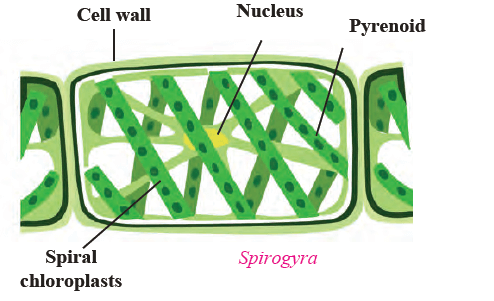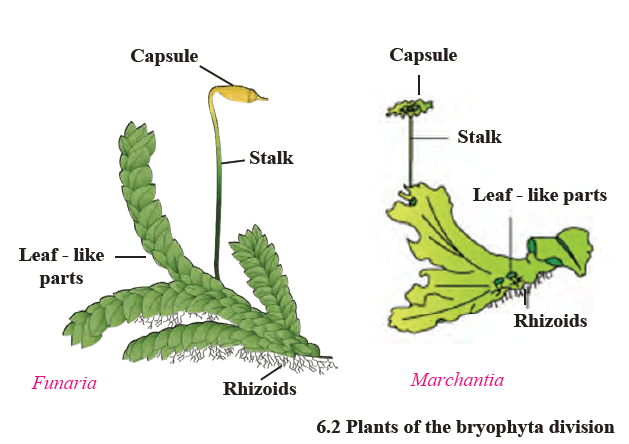Need help? We're here to assist you!
Thank You for Enquiry, we will contact you soon!
Close
The Class 9 is an important year in a student’s life and Maharashtra State Board Science is one of the subjects that require dedication, hard work, and practice. It’s a subject where you can score well if you are well-versed with the concepts, remember the important formulas and solving methods, and have done an ample amount of practice. Worry not! Home Revise is here to make your Class 9 journey even easier. It’s essential for students to have the right study material and notes to prepare for their board examinations, and through Home Revise, you can cover all the fundamental topics in the subject and the complete Maharashtra State Board Class 9 Science Book syllabus.

1. Match the proper terms from columns A and C with the description in column B.
| A | B | C |
| Thallophyta | Seeds are formed in fruits. | Fern |
| Bryophyta | No natural covering on seeds. | Cycas |
| Pteridophyta | These plants, mainly grow in water. | Tamarind |
| Gymnosperms | These plants need water for reproduction. | Moss |
| Angiosperms | Tissues are present for conduction of water and food | Algae |
Answer:
| A | B | C |
| Thallophyta | These plants, mainly grow in water. | Algae |
| Bryophyta | These plants need water for reproduction. | Moss |
| Pteridophyta | Tissues are present for conduction of water and food. | Fern |
| Gymnosperms | No natural covering on seeds. | Cycas |
| Angiosperms | Seeds are formed in fruits. | Tamarind |
2. Write the characteristics of subkingdom Phanerogams.
Answer: Phanerogams are plants that have special structures for reproduction and generate seeds. Based on whether the seeds are enclosed in a fruit or not, phanerogams are classified into gymnosperms and angiosperms.
Division I –(Gymnosperms)
Mostly evergreen, perennial and woody, Gymnosperms bear male and female flowers on different sporophylls of the same plant. Their stem does not have branches and their leaves form a crown. Seeds from these plants do not have any natural coverings. They do not produce fruits and so the name (gymnos: naked, sperms: seeds). Examples- Cycas, Picea (Christmas tree), Thuja (Morpankhi), Pinus (Deodar) and so on.
Read further about gymnosperms here.
Division II- Angiosperms
When you soak the seeds of corn, beans, groundnut, tamarind, mango, wheat, and more in water for 8 to 10 hours, check each seed to see whether it divides into two equal halves or not. The flowers that these plants produce are their reproductive organs and it develops into fruits. Seeds are formed within fruits. Thus, these seeds are covered; hence, they are called angiosperms (angios: cover, sperms: seeds). Meanwhile, the plants whose seeds can be divided into two equal halves or dicotyledons are called dicotyledonous plants and those whose seeds cannot be divided into equal parts are called monocotyledonous plants.
More about angiosperms discussed here.
3. Distinguish between monocots and dicots.
Answer: The plants whose seeds can be divided into two equal halves or dicotyledons are called dicotyledonous plants and those whose seeds cannot be divided into equal parts are called monocotyledonous plants. Given below are the two points that help to distinguish between dicots and monocots:
| Dicotyledonous plants | Monocotyledonous | |
| Seed | Two cotyledons | Single cotyledon |
| Root | Primary root (Tap root) that are well developed | Fibrous roots |
| Stem | Strong, hard. Ex. Banyan tree | Hollow, Ex. Bamboo
False, Ex. Banana Disc-like, Ex. Onion. |
| Leaf | Reticulate venation | Parallel venation |
| Flower | Flowers with 4 or 5 parts or in their multiples (tetramerous or pentamerous) | Flowers with 3 parts or in multiples of three (trimerous). |
4. Write a paragraph in your own words about the ornamental plants called ferns.
Answer: Belonging to the Pteridophyta group, ferns have well developed roots, stem and leaves and even separate tissues for conduction of food and water. However, they do not produce flowers and fruits. They reproduce with the help of spores that are formed along the back or posterior surface of their leaves. These plants reproduce asexually using the spore formation method and sexually via zygote formation. The conducting system they have is well-developed.
Examples are ferns such as Nephrolepis, Marsilea, Pteris, Adiantum, Equisetum, Selaginella, Lycopodium and so on.
Know in detail about Pteridophyta here.
5. Sketch, label and describe the Spirogyra.
Answer : Spirogyra is a part of Thallophyta group and grows mainly in water. They do not have specific parts such as root-stem-leaves-flowers, but are autotrophic due to the presence of chlorophyll. They are known as algae. Microscopic or large, they can also be unicellular or multicellular. Some of these are found in fresh water while some are found in saline water. These plants usually have a soft and fibre-like body. Keep learning more about Thallophyta here.

6. Write the characteristics of the plants belonging to division Bryophyta.
Answer: Known as the ‘amphibians’ of the plant kingdom, Byrophyta need water for reproduction, even if they grow in moist soil. Thalloid, multicellular and Autotrophic, these plants reproduce by spore formation. The plant body of bryophytes is flat, ribbon-like long and has no true roots, stem and leaves. Instead, they have stem-like or leaf-like parts and root-like rhizoids. They do not have specific tissues for conduction of food and water. Examples are Moss (Funaria), Marchantia, Anthoceros, Riccia, and so on.
7. Sketch and label the figures of the Marchantia and Funaria.
Answers:

8. Which criteria are used for the classification of plants? Explain with reasons.
Answers: One of the main criteria for classification of plants is the presence or absence of organs. Presence or absence of separate conducting tissues for conduction of water and food and so on are also other criterion. Another aspect is to see if the plants produce seeds or not. In case they do, then they need to check if the seeds are enclosed in a fruit or not. Finally, plants are also classified based on the number of cotyledons in the seeds. Other factors considered include the absence or presence of flowers, fruits and seeds. The plants are classified as cryptogams or phanerogams. Based on whether seeds are enclosed within a fruit not, phanerogams are classified as gymnosperms and angiosperms. Angiosperms are then further classified as monocots or dicots depending upon the number of cotyledons in seeds.
9. Why have plants become autotrophic?
Answer: Plants have become autotrophic because they can perform photosynthesis with the help of chlorophyll.
10. Which are the group of autotrophic living organisms having eukaryotic cells?
Answer: Plants are the group of autotrophic living organisms that have eukaryotic cells with cell walls.
11. Who classified Kingdom Plantae into two subkingdoms? What were they?
Answer: Eichlet, a botanist in 1983, classified the Kingdom Plantae into two subkingdoms- the cryptogams and the phanerogams, which are considered for plant classification.
12. What is the similarity between the plants of the groups Thallophyta, Bryophyta and Pteridophyta irrespective of differences in their body structure?
Answer: Thallophyta, Bryophyta and Pteridophyta, all reproduce by spore formation. They are known as cryptogams as their reproductive organs cannot be seen. (cryptos: hidden, gams: reproductive organs).
13. What are phanerogams?
Answer: Phanerogams are plants that have special structures for reproduction and they produce seeds. In these plants, after the process of reproduction, seeds are formed that contain the embryo and stored food, which is used for the initial growth of the embryo, during germination of the seed. Also, according to if the seeds are enclosed in a fruit or not, phanerogams are divided into gymnosperms and angiosperms.
14. During germination of the seed, what are the stored food in the seed of the phanerogams used for?
Answer: During germination of the seed, the stored food in the seed of the phanerogams is used for the initial growth of the embryo.
15. Which group of plants reproduce with the help of spores?
Answer: Pteridophyta do not produce flowers and fruits. They reproduce with the help of spores that are formed along the back or posterior surface of their leaves.
16. Name some examples of ferns.
Answers: Examples of ferns are Nephrolepis, Marsilea, Pteris, Adiantum, Equisetum, Selaginella, Lycopodium and so on.
17. How do Pteridophyta reproduce?
Answer: These plants use spore formation method to reproduce asexually, while sexually they reproduce by zygote formation.
18. Give some examples of Algae.
Answer: Examples of algae are Spirogyra, Ulothrix, Ulva, Sargassum, and so on.
19. Other than algae, what other organisms belong to the Thallophyta group?
Answer: Other than algae, other organisms that belong to the group include several types of fungi like yeasts and moulds that do not have chlorophyll.
20. What is Spirogyra?
Answer: Green fibres that are from the water with the spirally arranged green thread-like chloroplasts in its cells are called Spirogyra.
21. Which are plants from the group of autotrophic living organisms?
Answer: The group of autotrophic living organisms that have eukaryotic cells with cell walls is the group of plants.
22. Why are Bryophyta called the ‘amphibians’ of the plant kingdom?
Answer : Bryophyta group of plants is called the ‘amphibians’ of the plant kingdom as they grow in moist soil, nevertheless need water for reproduction.
23. Which are the root-like structures of the plant body of bryophytes?
Anwer: The structure of the plant body of bryophytes that is root like is the rhizoids.
24. To which group does the garden plants like Cycas belong to?
Answer: Cycas belong to Gymnosperms.
25. What are the examples of Angiosperms?
Answer: Corn, beans, groundnut, tamarind, mango, wheat and so on are examples of Angiosperms.